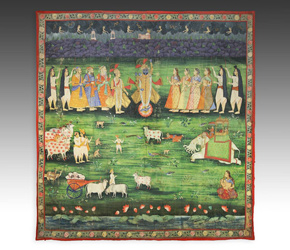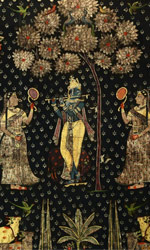The Look of Love – Pichvai from Nathdwara and the Deccan Plateau
PRIMITIVE - Wednesday, August 19, 2015By Misaki Imagawa
 |
|
Indian devotional paintings called pichvais always tell stories about Krishna, the Hindu God of Love. You might say, pichvais tell love stories. In one story, Krishna grows up in a peaceful cow herding village at the foot of Mount Govardhan. He was chosen to lead a ceremony where villagers were going to make offerings to Indra, the god of rain and storms; which they did each year because they feared the consequences if they did not. Young Krishna refused to lead the ceremony, claiming he did not agree with making sacrifices out of fear. Instead, he convinced the people to make offerings to Mount Govardhan, whose hills nourished their herds and protected the village; and further, to make their offerings out of love. Predictably, Indra became furious and sent punishing storms that flooded rivers and destroyed the crops; but Krishna, moved by compassion and wanting to prove his point about love, lifted Mount Govardhan with a single finger and sheltered all the inhabitants of the village for seven days and nights. Finally, Indra relented and admitted defeat, and from that point on the villagers honored Krishna and Mount Govardhan out of pure love and devotion.
 |
|
This story of Krishna's victory over Indra marked an important historical departure from earlier devotional traditions stressing the need to appease gods with sacrifices and acts of asceticism; in other words, to worship out of love, not fear. In the 15th century, a philosopher named Vallabhacharya began to preach the belief that complete devotion, love and surrender to the gods – especially Krishna – was the key to attaining his grace and enlightenment. He started a new sect called Pushti Marg. Devotees celebrated joyously, sang and danced without reserve, and gave themselves fully to Krishna as a means of attaining his grace, called pushti, which came in the form of all sorts of earthly pleasures. Pushti Marg means “the path of grace.”
 |
|
A very high form of devotional painting called pichvai manifested itself among the multitude of arts that developed around Pushti Marg. In Hindi, 'pich' means 'back' and 'vai' means 'hanging.' Taken together these words provide an apt description of pichvais, which are large, decorative paintings hung behind tables or mats filled with offerings and statues of Krishna. All pichvai depict Krishna and were meant to illustrate mythological stories, the spirit of the season or the theme of a festival. Subject matter was commonly derived from words of verses sung at festivals and special occasions. The vast majority of pichvais were created in the state of Rajasthan, one of India’s most colorful states.
 |
 |
||
In Rajasthan lies the village of Nathdwara, where Krishna is worshipped in the form of Shrinathji, a young blue boy. Shrinathji is the central deity of Pushti Marg. The Nathdwara School of painting, a stylistic school known for its soft color palette, large vocabulary of pigments, and use of gold foil almost always depicted Krishna as Shrinathji. These pichvais most often show Shrinathji clothed in rich garments and adorned with jewelry and garlands of flowers. There is nothing austere about these depictions. They are joyful, brightly colored hangings painted with exceptional detail on large cotton cloth canvases and further embellished with gold leaf. Each pichvai tells a specific story or event from Krishna's young adult life as a playful, mischievous boy who was nevertheless loved by all the villagers. The gopi, or milk maids, would flock to young Krishna, irresistibly drawn to him as he played his flute. In one pichvai the gopis hear the magical strains of Shrinathji's flute and come out of their homes under the light of a full moon. On the banks of the river where lotus flowers bloom they gather to dance, but each gopi wishes to hold Shrinathji's hand. So Shrinathji duplicates himself so each gopi will have him as a partner. This pichvai is known as the Rasa Lila. The gopis can be viewed as a representation of humankind; and the moral of the story appears to be that love is available to us all.
 |
|
It is not only the gopis who adore Shrinathji. Many pichvais depict sacred cows, birds and other animals, all bearing offerings for young Krishna. Some pichvais depict Krishna encircled by cows, commemorating his childhood achievement of going from being a caretaker of calves to being a fully fledged and divine herdsman. Could it be the lesson here is love must be nurtured to grow?
Painting a pichvai was considered a sacred act, a form of sewa, or complete devotion to Krishna. This adoration and devotion made itself manifest in the details of these paintings, which were considered essential to successfully convey the stories pichvais tell. For example, in the story of Krishna lifting Mount Govardhan, he is usually portrayed with his left arm raised. Some pichvais are painted with episodic borders that narrate singular events in the deity's life. Attention is usually paid to their sequence. The moon, sun, lotus flowers, trees and river banks often relate to a specific time of day and season, which are crucial to the Pushti Marg sect. In addition to actually being an offering to Krishna – one given out of love – pichvais also set the mood for festivals and events in the liturgical calendar and were displayed accordingly in temples, especially the Havelli of Shrinathji, one of the most prominent of all Krishna temples in India, located in Nathdwara itself.
 |
 |
||
Unlike the colorful pichvais from the Nathdwara School, there is another type of pichvai that developed around the same time in a southern area of India called the Deccan Plateau. These have simply been called “Deccani.” Deccani pichvais are much less colorful than those from Nathdwara, yet equally dramatic. They are made by stenciling images onto blue black, deep red or indigo cotton and applying gold or silver foil, one commonality between the two types of pichvai. However, what they lack in color is made up for in more graphic and less painterly images as well as the more liberal application of gold and silver. The result exudes an opulent form of sewa. Another difference between Deccani and Nathdwara pichvais is that Deccani sometimes do not depict Krishna at all in figurative form. Instead, he is represented by the kadamba tree, which grows around an area called Vraja, known as Krishna's home in mythology. The kadamba tree is also considered the ‘Tree of Life and All Knowledge,’ symbolizing Krishna as a universal axis, a central point connecting heaven and earth.
Outside the religious sphere, pichvais are admired for their enchanting visuals and precise detailing. One can almost see the gopis' skirts swaying as they dance, hear the cow’s moos echoing in the fields, and believe Krishna is actually lifting a mountain with a single finger. Yet, once you look beyond the seductive beauty of these paintings there is a universal message to be discovered; and whether Krishna is portrayed as a prank-loving child, a romantic musician or a solitary tree, how he is portrayed is less important than the message itself. This message is purely non-denominational. It is as old as humankind and cuts across all boundaries and cultures. No special knowledge of Krishna’s stories are required for its understanding; but once found it represents a call to action prompting us to act accordingly. It simply says, one sure way to receive love is to give love.
 |
Download this Article: The Look of Love - Pichvai.pdf